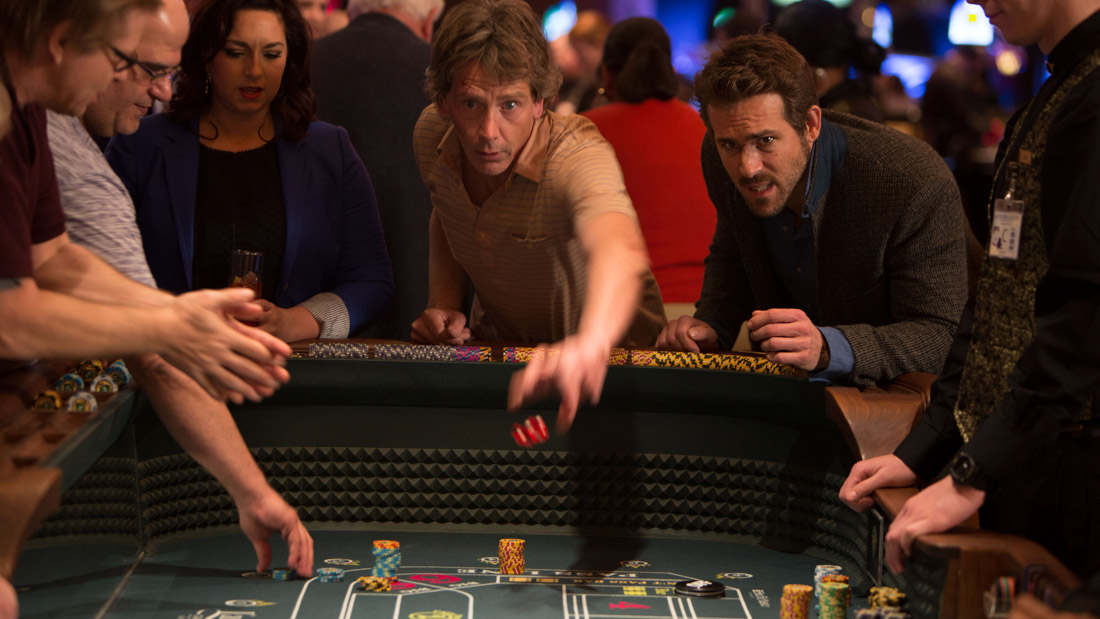Some films screened in Park City will either never make it
to audiences or take a remarkably long time to get there. For example, one of
last year’s biggest acquisitions, “Infinitely Polar Bear,” still hasn’t made it
to theaters, while several of last year’s most-buzzed hits (“Blue Ruin,” “The
Double,” “Locke”) were available nationwide shortly. There are even some films
that never get picked up and languish in obscurity until quiet VOD releases
(most people probably don’t even know that recent releases “Song One” and
“Little Accidents” were Sundance 2014 offerings). This odd distributional
unpredictability creates a little bit of prognosticating among Sundance
journalists—When do you think that will come out? Who will buy it? Most of all,
will it find its audience? Here’s a quartet of films that I feel almost certain
will find their audience. Whether their audience likes the film or not is
another story. All four films have flaws enough to hold them back from
greatness but fans of their stars or subject matter may not care.
The best of the four is Anna Boden and Ryan Fleck’s “Mississippi Grind,” starring Ben
Mendeloshn and Ryan Reynolds as a pair of lovable loser gamblers going all-in
on a gambling trip designed to earn the stake for an infamous poker game. Boden
and Fleck open their film with an image of a rainbow followed by the reflection
of neon in a car—natural wonder vs. man-made. Gerry (Mendelsohn) lives in the
world of man-made light, a gambling addict near the bottom of his barrel. All
he listens to in his car is a recording of poker-playing tips, and he seems
socially awkward at most times. But the far-more-gregarious Curtis (Reynolds)
sees something in him. They form an interesting duo for a road trip movie as
Gerry is the better poker player and Curtis seems to be his good luck charm. Of
course, everyone catches a bad break in cards every now and then.
At first, “Mississippi Grind” has that lived-in feel that
fans of Boden & Fleck’s brilliant “Half Nelson” and “Sugar” will recognize.
With his unkempt hair and unbuttoned shirt, Mendelsohn’s Gerry has clearly
pushed his gambling luck past the breaking point. Anyone who has spent any
significant time in a casino knows that feeling that the gambling Gods have
turned their backs. One minute you’re up, the next minute the dealer is drawing
to blackjack hand after hand after hand…and you know you should get up. Those
who do get up and walk away survive. Gerry doesn’t know when to get up. And
Mendelsohn perfectly captures the spirit of a man perfectly aware that he’s
drowning even as he charts a course for deeper waters.
Unlike most films about gamblers that paint them in coats of
moral messaging, “Mississippi Grind” isn’t afraid to let us like Gerry and
Curtis. Yes, Gerry’s addiction broke his home apart, but, unlike so many Hollywood
gamblers, he seems like someone worth saving. And Curtis is similarly just a
nice guy who gets drawn into the self-abuse of the world of gambling. He knows
he’s not very good at it—which is why he need Gerry—but he’s too entertained by
the game of it all to stop. And the wandering life of the casino jumper appeals
to him too much.
The character work by Mendelsohn and Reynolds elevate what
is ultimately a somewhat disappointing script. Many people in Sundance have
already written about the multiple endings here, but I would argue that if the
set-up was stronger than we wouldn’t mind. Watching Gerry & Curtis sit
around and talk over Woodford Reserve or play darts has that lived-in charm at
which Boden & Fleck excel. The formulaic narrative? Not so much. As Gerry
and Curtis were heading into their final run, I was surprised at how little
skin I had in the game. We need to feel like we are stuck at that breaking-bad
table with these guys, when the narrative flaw here make it much too easy to
walk away.

James Franco happened to have two major films premiering at
Sundance 2015 this year that fell victim to the same problem of solid acting
betrayed by inferior screenwriting or ill-advised direction. “Mississippi Grind”
is a better film than either Franco drama, as both “I Am Michael” and “True
Story” frustrated me in surprisingly similar ways in that they’re both
based on fact and yet can’t find a way to feel genuine cinematically.
The better of the two films is the one likely to make a
decent amount of money when Fox Searchlight releases it next week: “True Story,”
starring Franco, Jonah Hill and Felicity Jones. Hill plays Michael Finkel, a
very successful young writer for The New
York Times, with numerous magazine cover stories with his byline. The film
opens with Finkel researching a story about child laborers in Africa, which
turns into a fascinating cover story. Small problem: Finkel fudged the facts.
The young man on the cover is not who Finkel says he was and some of the people
in the article have been combined into one. When his journalistic deception is
uncovered, he’s fired, and has incredibly difficulty finding a new job with a
Scarlet A on his chest.
Then something amazing and unpredictable happens to Michael.
A father of three has been accused of murdering his family and going on the run
to Mexico. When the authorities apprehend him, he says his name is “Michael
Finkel of The New York Times.” Why would Christian Longo (James Franco) pretend
to be a journalist? And why would he kill his family? Or did he? Michael senses
that getting to the bottom of the story of the man who took his name might be
what the journalist needs to find himself again. And make for a hit book. But how
does he avoid being manipulated by a sociopath himself? Can he possibly?
Much of “True Story” consists of dialogue scenes between
Michael and Christian in which the two play cat-and-mouse games to get what
they need from each other. Michael needs the book that will save his career.
What does Christian need? It’s unclear at first although I would argue that it
takes Michael way too long to suspect why someone mounting a defense would want
to be a better writer. It’s unclear whether or not Christian is guilty, but
would you so casually take the risk of teaching a man accused of killing his
family how to craft a narrative if you didn’t know? The stakes of this entire
enterprise feel cinematically forced in a way that drains them of their
realism.
The bigger problem is that Rupert Goold’s direction
vacillates between over- and under-cooked throughout. Moments deemed of great
importance will be shot in slo-mo to swooping scores while intense dialogue
exchanges between Michael and Christian aren’t given any time to breathe. “True
Story” would have worked better with a more realistic approach, pulling up a
seat in those exchanges between two men trying to fix their broken lives, but
Goold keeps coming back to the mystery too often. The mystery of whether or not
Christian Longo did it is nowhere near as interesting as why Michael needs him
so badly to save his own skin. His reputation has been destroyed to the point that
he’s on a professional death row himself. Franco makes some very smart
decision, but the overall product needed a different, subtler approach to
connect.

I could say the exact same thing about “I Am Michael,” another film anchored by strong work by Franco that’s
even less effective than the mystery-drama he brought to Park City this year. Rarely
have I been as frustrated by the first act of a film at Sundance as I was by
the superficial opening scenes of Justin Kelly’s drama. In it, we meet Michael
Glatze (Franco), a famous gay rights activist in San Francisco in the ‘90s. And
we meet him in the most clichéd ways of representing gay culture possible—gay club
scene, discussion of the Matthew Shepard case, playing Tori Amos casually on a
piano. It’s almost a parody. The sense that Kelly and his team are taking very serious subject matter and refusing to explore it in any depth at all
pervades the entire piece, even if it does improve in the second half.
In 2007, after years of being a successful gay rights
blogger, Glatze announced something amazing—he was no longer gay. And he
believed that being gay was a choice. How did he reach this point? After a
series of panic attacks convinced Michael he was going to die, he turned to The
Bible, which he interpreted as instructive that his lifestyle would send him to
Hell. He decided that he didn’t want to take that road and starting encouraging
gay people to reject their homosexuality, much to the dismay and detriment of a
community he helped build.
It’s an undeniably fascinating story but Kelly can’t find
the right way into it. I’d much rather read an essay about Glatze or even a
book than see a film in which every single supporting character is merely a
device for his arc. Poor Zachary Quinto does his best to turn the ex-boyfriend
into more than a sounding board for Glatze but the film won’t let him, and he’s
much better off than the other supporting players who exist merely to push
Michael’s story forward. Michael Glatze didn’t turn against the gay community
in a vacuum, and there’s a much stronger telling of this story that recognizes
that the people around him and those impacted by him were just as interesting
as he was, maybe even more. The best scene in the film features a young man
convinced to be himself by Michael meeting up with him for a final time. The
heartbreak in his eyes is what I’ll remember most about “I Am Michael.”

Finally, there’s Joe Swanberg’s dramedy “Digging For Fire,” co-written by and starring Jake Johnson, who
did his best film work to date in the director’s “Drinking Buddies.” The divisive
writer/director gathered a dozen or so Sundance vets (including Anna Kendrick,
Sam Rockwell, Brie Larson, and more) to fill out this examination of individual
vs. couple in modern married life. How do we keep our own personalities within
the definition of being a married couple? Swanberg explores the concept not by
forcing a husband and wife together but separating them for a weekend and seeing
where they go. As Lee (Rosemarie De Witt) takes their son (Jude Swanberg) to
visit her parents, before going on a bit of an adventure of her own, Tim
(Johnson) stays back at the house they’re sitting for one of her yoga clients.
Instead of doing taxes as he should, he becomes obsessed with digging the
hillside nearby after finding a gun and a bone there. What’s underground? He
even invites friends over for some drinking, drugs, and digging.
The best parts “Digging For Fire” have a loose, improvised, believable
energy, especially resonant because of great work by Rosemarie DeWitt, but the
overall effect is a little muted due to the sense that the entire project
needed a little more time to develop. There’s enough character work to like
here, especially for fans of Swanberg, and it’s very nice to see the director shooting
with visual eloquence on film, but a few unbelievable beats and repetitive
decisions keep it from being ranked among his best. Although this is one that
will surely find its audience outside of Park City. And I suspect they’ll be satisfied
when it does.












